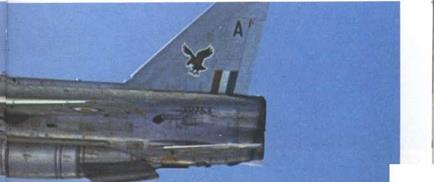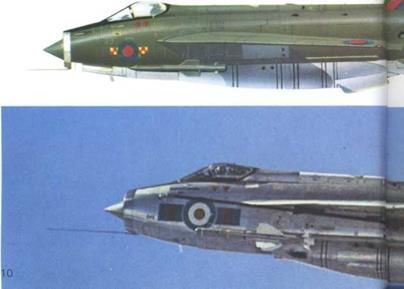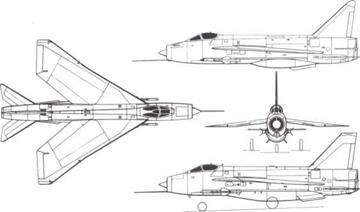ВАС (ВАе) Lightning
Lightning F.1 to 6 and export versions (data for F.6)
Origin: English Electric Aviation (now British Aerospace), UK.
Type: Single-seat all-weather interceptor.
Engines: Two 1 5,680lb (711 2kg) thrust Rolls-Royce Avon 302 augmented turbojets.
Dimensions: span 34ft 10in (10 6m): length 53ft 3in (16-25m); height 19ft 7in (595m).
Weights: Empty about 28,000lb (12,700kg); loaded 50,000lb (22,680kg). Performance: Maximum speed 1,500mph (2415km/h) at 40,000ft (12,200m): initial climb 50,000ft (15,240m)/min; service ceiling over 60,000ft (18,290m); range without overwing tanks 800 miles (1290km). Armament: Interchangeable packs for two all-attitude Red Top or stern – chase Firestreak guided missiles; option of two 30mm Aden cannon in forward part of belly tank; export versions up to 6,0001b (2722kg) bombs or other offensive stores above and below wings.
History: First flight (P.1 B) 4 April 1957; (first production F.1) 30 October 1959; (first F.6) 17 April 1964.
Users: Kuwait, Saudi Arabia, UK.
Development: As he had been with the Canberra, "Teddy" Petter was again moving spirit behind the award, in 1947, of a study contract for a supersonic research aircraft. Later this was built and flown as the P.1 of August 1954, exceeding Mach 1 on two crude unaugmented Sapphire engines mounted one above and behind the other and fed by a plain nose inlet. In mid-1949 specification F.23/49 was issued for a supersonic fighter, and after complete redesign the P.1 В was produced and flown in 1 957. This had a new fuselage with a two-shock intake, the central cone being intended to house Ferranti Airpass radar. The Avon engines were fitted with primitive afterburning, allowing a speed of Mach 2 to be attained on 25 November 1958.
Helped by 20 pre-production aircraft, the Lightning F.1 was cleared for service in 1960. Though relatively complicated, so that the flying rate and maintenance burden were terrible in comparison with more modern aircraft, these supersonic all-weather interceptors at last gave the RAF a modern fighter with radar, guided missiles (heat-homing Firestreaks) and supersonic performance. Production was held back by the belief that all manned fighters |a
|
|
|
were obsolete (as clearly set forth in the Defence White Paper of April 1 957), but the Treasury were persuaded to allow the improved F.2 to be built in 1961 with fully variable afterburner and all-weather navigation. Eventually, as the error of the 1 957 doctrine became apparent, the Mk 3 was allowed in 1964, with more powerful engines, more fuel, bigger fin, collision-course fire-control and allattitude Red Top missiles: but it was decided to fit no guns, earlier marks having had two 30mm Aden cannon. Finally, in 1965, the belated decision was taken to follow the advice of ВАС and almost double the fuel capacity and also fit the kinked and cambered wing (first flown in 1956) to improve operation at much increased weights. The T.4 and T.5 are dual conversion trainers equivalent to the F.2 and F.3. For Saudi Arabia and Kuwait, ВАС paid for development of the Lightning as a multi-role fighter and attack aircraft, adding 57 to the production total to Dring it up to 338.
 Left: One of the Lightning F.2A interceptors of 92 Sqn, RAF Germany (a unit since re-equipped with Phantoms) in the one-colour green applied over all upper surfaces to render them less conspicuous when viewed from above.
Left: One of the Lightning F.2A interceptors of 92 Sqn, RAF Germany (a unit since re-equipped with Phantoms) in the one-colour green applied over all upper surfaces to render them less conspicuous when viewed from above.

Below: This Lightning is an F.6, the final standard to which the F.2A (a complete rebuild of a much earlier type) was a near approximation. It is shown unpainted serving with 23 Sqn, and was photographed whilst formating on a Soviet ‘Bear’ reconnaissance and electronic-warfare aircraft. Today IMo 23 also flies Phantoms.












